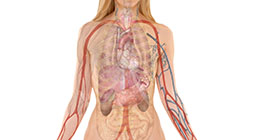
Overview
Symptoms
Causes
Prescription
Health Tips
According to medical texts, the average age for the beginning of sexual maturation for females is around age 11 with breast budding, while first menstruation usually occurs around age 13. Puberty occurring between the ages of 9 and 16 for girls is considered normal. For some girls however, sexual maturation arrives early, and is considered precocious puberty when the process begins before 8 years of age.
For boys, puberty between ages 13 and 15 is considered normal. Puberty beginning before the age of 9 is precocious. While boys in North America are starting puberty earlier than previous generations, precocious puberty is less likely to occur in boys and is more often caused by an underlying disease. However, exposure endocrine disruptors have been shown to reduce the age of puberty in both boys and girls.
Symptoms
Some children may experience partial precocious puberty at a very young age. For example, budding breasts that later go away, or early growth of pubic hair with no other changes. It is important to monitor these changes, but they usually do not need treatment and the remaining changes of puberty will likely come at a normal age. True precocious puberty involves the development of both the exterior and interior organ changes associated with adulthood, while pseudo-precocious puberty refers to changes in the outward appearance only.
In girls:
- Breast development
- Menstruation
In boys:
- Facial hair growth
- Testicular and penile growth
- Voice may become deeper
In both girls and boys:
- Acne
- An early growth spurt that typically results in an early stopping of growth
- Changes in body odour
- Pubic and underarm hair
Causes
Sometimes a tumor or other abnormality in the pituitary or hypothalamus may cause the condition, but this only accounts for about 20 percent of the cases of precocious puberty in girls over the age of six. Low thyroid hormone levels may be another factor responsible for precocious puberty.
Some doctors also theorize that low birth weight causes a rapid “catch-up phase” that triggers early puberty, while others suggest that North Americans are overeating and under-exercising, causing additional fat that stores estrogen. A 2002 study linked female obesity with the onset of early puberty. In North America, one in four children between the ages of 2 and 5 are obese. Diets lacking in fruits and vegetables also do not provide sufficient fiber, which is necessary for excreting excess estrogen from the body.
Complicating the internal hormonal environment are the numerous hormones that are injected into meat and become part of the dairy products that are fed to children. In addition, estrogen mimickers, technically known as xenoestrogens (pronounced ZEE-no-estrogens) are found in everything from plastic toys to food, cleaning agents, and medical supplies. Similar to estrogen in structure, these chemicals bind to estrogen receptor sites throughout the body and cause the same reactions as estrogen. Most cosmetic products contain estrogen-like compounds; young girls fascinated with sparkly makeup and perfumes are being exposed to xenoestrogens every time they play dress-up with these products. Research is now linking certain chemicals to the development of early puberty in girls.
Diets high in processed foods and refined sugars congest the liver, the large intestine, the colon and the kidneys. With so many toxins to process, these organs cannot possibly neutralize all additional estrogen mimickers in the body.
Studies have shown that girls raised in stressful homes may be at an increased risk of precocious puberty. For example, girls in a single parent home, children who have a parent with mental illness, and girls from families that are often in conflict. All types of ongoing stress (emotional, physical, social) and the contributing factors noted above appear to help reduce the age at which onset of puberty occurs.
Prescription for Health
Precocious puberty has a number of negative effects, so it is important to address these. There may be increased risks of hormone-related cancers, and if obesity is an underlying issue heart disease and diabetes risks also increase.
Diet
- Consult the EWG Dirty Dozen and Clean Fifteen lists for safer cosmetics.
- Eat a predominantly vegetarian diet with 7 to 10 servings of fresh produce daily and 25 g of fiber to help naturally eliminate estrogen. Girls raised on a complete vegetarian diet begin their menstrual cycles later than those who eat a high meat or dairy product diet.
Lifestyle
Maturing physically ahead of one’s peers may make it harder for a child to fit in and affect him/her psychologically by increasing stress, depression and an unhealthy body image. Body image and insecurities may be especially problematic for girls who appear older than they are, as they may be sexualized by people around them much earlier than usual.
Address childhood obesity through proper diet and exercise. Make this fun for the whole family. Improving the lifestyle of the whole family will reduce chances of children feeling shame or guilt about excess weight and will help to avoid an unhealthy body image.
Use “clean” body care and home cleaning products that are free of contaminants instead of the conventional brand products which are often full of endocrine disrupting chemicals. Check product safety on EWG’s Skin Deep site for best options.
Drugs used to treat precocious puberty may have potentially serious side effects. Be sure to review these with the child’s doctor before committing to a specific treatment.
| Nutrient | Dosage | Action |
|---|---|---|
| Multivitamin with minerals (contains no iron) | As directed | Ensures adequate nutrient status |
| Calcium D-glucarate* | 150 mg
|
Important for healthy metabolism of estrogen; supports normal cell growth |
| Curcumin* (95% curcumin) |
50 mg | Prevents abnormal cell growth, detoxifies cancer-causing forms of estrogen |
| Indole-3-carbinol* | 150 mg | Stops healthy estrogen from converting into cancer-causing forms
Has been shown to reverse abnormal PAP tests within three menstrual cycles |
| Green tea extract* | 100 mg | Protects against abnormal cell growth, detoxifies excess estrogens |
| Rosemary extract* | 25 mg | Reduces tumor formation; Antioxidant |
| Di-indolylmethane (DIM)* | 50 mg | Antioxidant; reduces risk of cancer |
| Sulforaphane* | 200 mcg | Reduces risk of cancer; stops abnormal cell growth |
| BB536 Bifidobacterium |
A total of 5 billion active cells |
Improves intestinal flora (especially important if you have taken antibiotics for condition) |
| Borage Oil | 2000 mg borage oil daily | Anti-inflammatory; controls negative prostaglandins involved in pain and inflammation |
| D-Chiro-Inositol | 600–1200 mg | Normalizes insulin, restores hormone balance |
*Can be found in one form
Health Tips to Enhance Healing
- Address childhood obesity through proper diet and exercise.
- Avoid exposure to BPA which is found in baby bottles, sip cups, pacifiers, water bottles, and metal cans; opt for brands that are BPA-free.
- Avoid microwaving foods in plastic wrap as this leaches xenoestrogens into the food.
- Avoid soy products such as milk and tofu.
- Consume only wild fish and organically-farmed meat and produce to reduce the chemical burden in the body.
- Do not use bubble bath, personal care or home cleaning products that contain phthalates, parabens and other toxic chemicals.
- Do not use plastic to store food and beverages; opt for glass, stainless steel or porcelain.
- Eat a predominantly vegetarian diet with 7 to 10 servings of fresh produce daily and 25 g of fiber to help naturally eliminate estrogen.
- For young girls who have started menstruating, avoid commercial pads, panty liners and tampons which may contain many irritating and endocrine disrupting chemicals. Instead choose products made from organic cotton or reusable menstruation cups.
- Include essential fatty acids from fish, flax, nuts and seeds.
- Once weaned, children should take a multivitamin with minerals throughout their lives.










